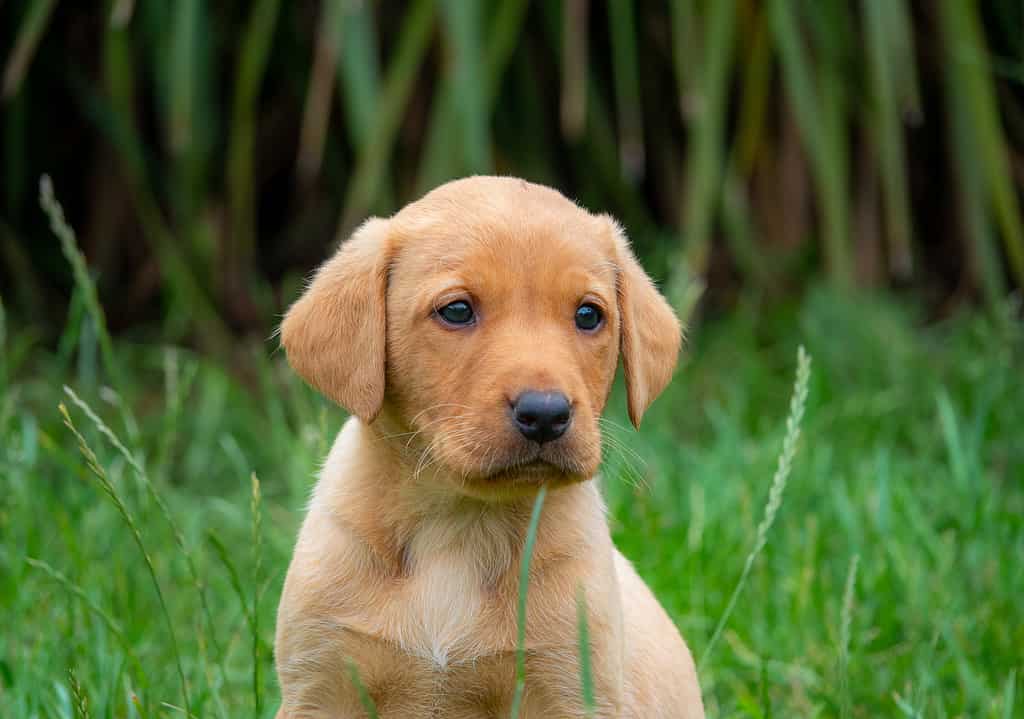Let’s demystify this dog “breed” right away: Red fox Labrador retrievers are the exact same breed as the Yellow Labrador Retriever. It isn’t that yellow labs are more common than red fox labs. They’re literally the same animal! The only difference is in coloration. It is rarer for a yellow lab puppy to be born that “red fox” shade (sometimes reversed and said as “fox red”). This is for genetic reasons we will cover within. Yet this is the literal only difference between Little Red and their sunnier litter-mates. In terms of temperament, behavior, growth rate and health concerns, your red fox lab is simply a yellow lab by another name — and in another colorway. So without further ado, let’s discover some things you might want to know about the rarer, yet otherwise identical, “Red Fox”-colored Yellow Labrador Retriever.
Red Fox Lab: An Introduction
Originally bred to help with hunting, the Yellow Labrador Retriever is an intelligent and energetic sporting breed descended from other American Labrador lines. This breed designation indicates that yellow labs are fast and strong with a high prey drive (tennis balls, anyone?). Yet all these other traits are perhaps outdone by the Yellow Lab’s tendency to be loyal and affectionate, meaning they make absolutely splendid pets. But make no mistake, your yellow lab, even if it’s a red yellow lab, needs to train from a young age to keep its chaos levels down at appropriate times and thrive as your pet. That intelligence, as in so many species, including its owner, can translate to sensitivity and nervousness. Introduce your red fox lab to new situations and people with care (but early and often!).
What to Expect From Red Fox Lab Puppies
When your red fox lab puppy is born, it will only be a little bit more reddish in hue than an average yellow lab. But that darker, ruddier shade will become more pronounced over its first weeks of life. By three weeks old, the change is mostly complete. By eight weeks old, around the time most dogs become adoptable to the general public, the full foxy colorway will have grown in. It’s worth keeping in mind that every dog has a slightly different color. Even if both your fox lab’s parents were fox labs, others in his litter could range from red to yellow to brown. (We’ll explain the genetic science behind that below.)
Your red fox lab descends from working dog breeds, as we’ve mentioned. You’ll want to train it with a lot of positive reinforcement training — popping a treat in their mouth whenever they do something right.
Your full-grown lab loves exercise, and you’ll want to make sure your baby pooch is good and pooped at the end of each day, but be careful not to over-exercise lab puppies, who will stay sweetly stumbly and uncoordinated in their first couple of months. A few minutes’ walkies will suit them fine until they’re a bit older. And you can definitely train them up as they reach full size, depending on whether you primarily want a running partner or a snuggling companion.

When your red fox lab puppy is born, it will only be a little bit more reddish in hue than an average yellow lab.
©Caroline Anderson/iStock via Getty Images
Where Do Red Fox Labs Come From
Once upon a time, nearly all Labrador retrievers were black. This is because the “black lab” gene is dominant; if even one chromosome for this trait is present, you’ll have a black puppy on your hand. Labs that are born yellow or chocolate are therefore rarer, because the puppy that turns out these colors must have only the recessive (non-dominant) genes for it.
So it was only when the lighter-colored labs grew more popular in the 1970s that humans began to breed for them. This was done by mating male and female labs who were both of the lighter colors. Black puppies can still be born to yellow or chocolate-colored parents. It’s a dominant gene, remember! But this combination has a far better chance of producing yellow or chocolate puppies. So over time, humans established the new, lighter-colored breeds of Labrador Retriever.
From this point in labrador evolution, people who keep working and sporting dogs actually came to prefer a darker version of the lighter version of the typical black lab — and began breeding yellow labs for a dark-yellow or fox-red hue (less of a giveaway when hunting wildfowl in the woods, you see).

A reputable red fox lab breeder will consider health above hue.
©Caroline Anderson/iStock via Getty Images
Can I Show my Red Fox Lab at a Dog Show?
No one’s denying this is a simply stunning dog — however, because the red fox lab is almost always a mixture of the two breeds of Labrador retriever that exist today, it can’t be shown as a purebred at an American Kennel Club dog show.
Those breeds, by the way, are the working American Lab and the show-bred English Lab. In order to pick the reddest specimens to breed, the two types of lab are selected and interbred freely. (This is, in fact, the responsible choice for breeders to make. Mating dogs of the same breed with a narrow focus on one trait such as coat color can lead to inbreeding. That in turn leads to less healthy puppies. By focusing on that red coat, but also using American and English labs, breeders keep the gene pool from growing stagnant.) English labs are a bit stockier in the chest and head, while American labs tend to be thinner and a touch more reserved. Your red fox lab gets the best of both, and may even have a pedigree, but in all likelihood isn’t technically a purebred.
Red Fox Labs and American Kennel Club Controversy
There are, however, some rare cases of “purebred” red fox labs. Some breeders of yellow labs certainly do keep the two breeds separate, and, as we’ve covered, some yellow lab pups just grow up redder! (For chemistry buffs, the pigment that makes these pups red is called pheomelanin.) So, in a small percentage of cases, you may seek out an American Lab and/or English Lab breeder, and discover a litter that includes a rusty-red individual.
Interestingly enough, there’s a bit of a controversy around showing those rare purebred red fox labs. Even with a single-breed pedigree, some dog showers claim, their red fox labs are unable to win Best In Show because according to American Kennel Club rules, these dogs are simply yellow labs with an imperfection! As you might imagine, the red fox owners beg to differ. But until the AKC recognizes labrador colors outside of black, chocolate and yellow, it seems the Red Fox Lab is unlikely to take home the top honors.
Where Can I Get a Red Fox Lab?
You might get lucky at a shelter, but to be honest, due to the difficulty of producing the red coat, you will probably purchase your red fox lab from a breeder. Also due to the problems inbred dogs can experience, which we discussed above, you may want to be extra sure when buying this color and breed that you are dealing with a reputable breeder and not a puppy mill.
Here’s an important clue: if the breeder says they only breed fox reds, you may want to avoid them. A reputable breeder will not make the color of their dogs the absolute top priority. This would mean that they’re ignoring important health concerns in the reckless pursuit of shade.
Keep in mind that every lab litter will have a range of colors; these colors can shift (usually darker) over time, or not. If your breeder is making promises about this, that could be — forgive us — a red flag. Better to be attentive to your puppy’s parents, and not their color. Are the parents in good health, with clear vision and healthy joints? Nothing, in the end, is more important than that.
Ready to discover the top 10 cutest dog breeds in the entire world?
How about the fastest dogs, the largest dogs and those that are -- quite frankly -- just the kindest dogs on the planet? Each day, AZ Animals sends out lists just like this to our thousands of email subscribers. And the best part? It's FREE. Join today by entering your email below.
Thank you for reading! Have some feedback for us? Contact the AZ Animals editorial team.








